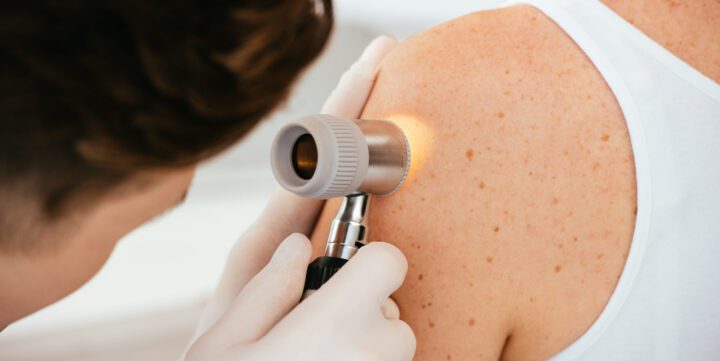Defining Evidence-Based Skin Checks this Summer
January 13, 2025
Building Evidence-Based Approaches to Early Detection
Australia’s sun-soaked lifestyle comes with a troubling legacy: the highest incidence of skin cancer per capita in the world. Skin cancer—often referred to as Australia’s national cancer—affects two-thirds of Australians at some point in their lives, and melanoma remains our third most common invasive cancer. Tragically, one Australian dies every six hours from melanoma despite advances in treatment. With summer approaching and the recent National Skin Cancer Action Week reminding us to protect and check our skin, it’s time to reflect on the state of skin cancer detection and the potential for evidence-based improvements in screening and care.
Current Strengths and Shortcomings
Routine skin checks are a common practice in Australia, with one-third of adults aged 45–69 reporting annual full-body checks. However, these checks, driven by individual initiative rather than a structured program, lack the national and international backing of evidence-based screening guidelines. While early detection leads to remarkable success rates—up to 98% survival for early-detected skin cancers—current practices have limitations. These include the overuse of biopsies, inconsistent diagnostic accuracy, and inequitable access across socio-economic and geographical lines.
The cost of managing skin cancer in Australia exceeds $2 billion annually, with unquantified expenses linked to unnecessary skin checks. This raises critical questions: Are we optimally balancing early detection with the potential harms of overdiagnosis? How can we better target resources to those most at risk? How can we better train and equip medical professionals to improve diagnostic accuracy?
The Role of Technology in Diagnosis
Diagnosing melanoma and other skin cancers remains a significant clinical challenge. Many benign and age-related lesions can closely resemble skin cancer, while some melanomas—particularly amelanotic variants—present with subtle or indistinct features that are easy to overlook. This complexity is further heightened by inconsistencies in the histopathological interpretation of borderline malignant melanocytic lesions. Research suggests that up to 50% of melanoma in situ diagnoses and 15% of invasive melanomas may represent overdiagnosed—cases that, if left undetected, would not have caused harm during the patient’s lifetime. These challenges underscore the need for thoughtful approaches to identifying high-risk individuals and carefully managing low-risk skin cancers or their precursors.
Achieving accurate, risk-tailored melanoma screening that minimises harm while maximising benefits requires addressing several key factors. Identifying individuals at high risk using validated risk prediction tools is critical, as is incorporating non-invasive imaging technologies to enhance diagnostic accuracy. Screening intervals should be tailored to individual risk profiles, and clear access pathways with shared care protocols between primary and specialist care must be established. Education and upskilling of health practitioners are essential to improving diagnostic competency, while remuneration models need to align with quality care to support effective practices. Ultimately, equitable access, high-quality care, earlier stages of diagnosis, and cost-effective interventions are the outcomes that must drive these efforts.
To address the challenges of improving diagnostic accuracy and reducing unnecessary interventions, technological advancements have introduced valuable tools. Dermoscopy, for instance, is an essential technique that enhances the specificity of diagnosing melanocytic lesions by magnifying and illuminating skin structures, helping to differentiate benign features from malignant ones. This tool significantly reduces the benign-to-malignant biopsy ratio and could enhance diagnostic accuracy if more widely incorporated into primary care practices, though its effective use requires extensive training.
Total body photography is another important advancement, particularly for high-risk patients, as it provides a baseline reference to track new or changing lesions over time. While effective, this technology poses logistical challenges, such as ensuring robust patient privacy protections and addressing significant upfront costs.
Similarly, sequential digital dermoscopic imaging captures images of suspicious lesions over time, making it possible to identify subtle changes that may indicate malignancy. This approach is particularly useful for equivocal lesions but also requires rigorous training to ensure accurate interpretation. Together, these tools offer promising avenues for improving skin cancer detection, provided the challenges of implementation and training are addressed.
Emerging Technologies
Emerging technologies are revolutionising the way skin lesions are assessed and diagnosed, offering potential improvements in accuracy and efficiency. In vivo reflectance confocal microscopy, a non-invasive imaging technique, provides near-histological resolution of skin lesions, enabling more precise evaluation of malignancy. Similarly, optical coherence tomography captures detailed cross-sectional images of skin layers, assisting in distinguishing benign from malignant lesions. Artificial intelligence decision support systems are also being developed to aid clinicians in lesion classification, promising to standardise care and reduce diagnostic variability. Another innovative approach involves biomarker analysis from tape-stripped samples, offering a non-invasive method to identify molecular markers associated with melanoma.
While these advancements hold great promise, they require thorough evaluation in real-world clinical trials to establish their cost-effectiveness, diagnostic accuracy, and seamless integration into existing clinical workflows. Additionally, the quality of skin checks could benefit from organised screening programs that standardise the diagnostic process, with clear guidelines for lesion selection, biopsy criteria, and follow-up care.
Evidence-Based Screening
The introduction of an organised, risk-tailored melanoma screening program could address many current challenges. Such a program would focus on identifying high-risk individuals through validated tools and tailoring screening intervals based on individual risk profiles. By targeting high-risk groups, such as those with a family history of melanoma, numerous moles, or significant sun exposure, resources could be better allocated, and unnecessary procedures in low-risk populations avoided.
However, implementing such a program raises critical questions. How can we train and upskill health practitioners to enhance diagnostic accuracy? How do we integrate new technologies while ensuring they remain accessible and cost-effective? And most importantly, how can we design a system that ensures equity in access and outcomes across diverse populations?
Prevention and Early Detection
While early detection is vital, prevention remains the most cost-effective strategy for reducing the skin cancer burden. The familiar “Slip, Slop, Slap, Seek, Slide” campaign continues to play a critical role in promoting sun safety, yet gaps remain in occupational settings where carcinogen exposure poses additional risks. Expanding preventive measures to include better workplace protections and targeted education for outdoor workers could significantly impact skin cancer rates.
Upskilling in Skin Cancer Care
To better equip health professionals for the challenges of diagnosing and managing skin cancer, numerous resources and educational opportunities are available. For example, online courses available on Med CPD, provided by the Cancer Council of Australia, focus on occupational carcinogen exposure and provide valuable insights into workplace risk factors associated with skin and other cancers. Additionally, training programs in dermoscopy and other diagnostic tools can enhance accuracy and confidence in clinical decision-making. Upskilling in areas such as morphological identification of high-risk lesions, interpretation of non-invasive diagnostic technologies, and effective patient communication will be critical. Moreover, investment in structured education programs, combined with research into emerging technologies, can pave the way for a national skin cancer screening framework that prioritises quality, equity, and evidence-based care. You can find more information about this course via the link – https://app.medcpd.com/courses/1402
As the summer sun intensifies, let’s commit to advancing skin cancer detection through innovative approaches, continued education, and collaboration among clinicians, researchers, and policymakers. By asking the hard questions and implementing the right solutions, we can build a smarter, more equitable system for skin cancer care.












